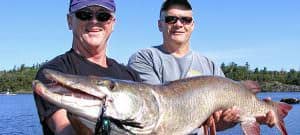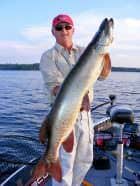Three Can’t-miss Tactics for Canadian Muskies
In my world, nothing compares to a fishing trip in the Canadian wilderness for big muskies. It is simply the ultimate of all fishing experiences. The unique combination of scenic beauty, vast wilderness waterways, and the raw potential for a big one to appear at any moment keeps me “stoked” on every cast.
You are apt to catch a good muskie on a wide variety of lures on any Canadian water, but three in particular are standouts. If you stick with these three tried-and-true tactics, it is almost certain that will score big on your next Canadian trip.
Here we go …
#1: Burning blades
Blades” are still the most popular muskie lure category of all. The term “blades” refers to any spinner-style lure, including those with traditional bucktail dressing as well as all kinds of synthetic skirts. They come in a wide range of sizes, colors and styles, but all have one thing in common: muskies love ‘em.
Cast your favorite spinner over a promising Canadian reef, shoreline or bay, engage the reel the moment the lure hits the water, and start burning it back to the boat. Do that for an entire week and you are likely to see a bunch of those “live torpedoes” in hot pursuit.
Nowadays, we have a much wider selection of both in-line and safety-pin style “blades” to choose from, and far better equipment to throw them with. Longer spinner lures with much larger blades are more the norm today, although smaller versions should still be considered when the bite is tough. The modern muskie marauder flings that big spinner on a powerful 8- to 9-foot, high-modulus graphite stick, outfitted with a brawny baitcaster sporting a 7:1 (or higher) gear ratio, spooled with mighty 80-pound-test super braid. The combination of an extra-long rod and solid figure-8 technique is sure to yield a high number of boatside strikes from following muskies. Longer rods and superior lines also do a much better job of keeping boatside battlers hooked.
#2: Time for topwater
Canadian muskies are apt to hang in shallow, castable depth ranges spring, summer, and fall, making them highly susceptible to topwater lures. In fact, a topwater is often the best bait you can throw at big muskies on any shallow Canadian reef, shoreline, or bay. Never assume muskies will only chase topwater lures in low light. That would be a mistake. I have taken some real brutes during midday in Canadian water on topwater lures.
My overall favorite surface lure, day in and day out, is the Topraider. Twice this past August, I caught a big muskie at midday from inside the middle of a thick patch of emergent cabbage weeds that was virtually unfishable with conventional in-line spinners and similar sub-surface lures. In one instance, my partner, Rich Belanger from St. Croix Rods, had fished the entire perimeter of a specific weed patch with a big in-line spinner, but had not attempted a cast right inside the actual clump, because he knew he’d get fouled up.
Inadvertently, I launched a cast with my Walkin’ Raider right over the center of the thickest portion of the weedy cluster. Due to the lure’s design and zigzag action, I was fairly confident I could walk the lure cleanly through the middle of the mass. As the Walkin’ Raider zigzagged its way into the center of the cabbage, a bomb suddenly went off, and the lure was gone!
A short time later, Rich slipped the net under one of my biggest fish of the summer. That muskie was uncatchable with most conventional lures. A topwater bait was clearly the best tool for the job here no matter what the time of day.
#3: Cold-front cranks
Cold fronts can be a frequent part of any Canadian muskie trip. However, cold fronts are not always the “kiss of death” that many anglers claim them to be. Success in post-frontal conditions often comes down to a slight alteration in tactics that takes advantage of a muskie’s tendency to stick tighter to cover during these conditions.
Muskies generally buck up tighter to cover after a front passes. Bluebird skies and a dry northerly wind, typical of such a situation, might prove fruitless to those who cast spinners and topwaters, but not to those who switch to a crankbait.
Back when I was still guiding, I made a living casting DepthRaiders to deep weed edges after cold fronts passed. I still rely on the same tried-and-true technique today, and it is a killer on Canadian cold-front muskies.
As soon as I stop seeing muskies chase blades and topwater, I snap on a diver and start probing the depths. My goal, on every cast and retrieve, is to tick bottom or purposely run the lure into cover, whether it’s weeds, rocks, or wood. If I don’t succeed in contacting cover, I will tactfully cast right or left of my previous cast, in an attempt to do so.
As soon as my diver contacts cover, I back off on the retrieve speed and begin a game of “bump and rise.” In other words, I want the lure to bump into cover, and then rise up or back out of it in response. Obviously, this is best accomplished with a floating diver.
The same concept can be applied over spots with less depth using a shallow-running crankbait such as slab-minnow style lures, with similar floating/diving characteristics. Success with this tactic centers on your ability to “bump and rise” the lure through weed cover without collecting debris. A lure that comes back with weeds or other debris clinging to it is essentially a wasted opportunity. Constantly cleaning the bait is one of the keys to success and one of the strongest triggering mechanisms. As soon as you sense the lure has risen up from the bottom contact or out of cover, a sharp, short snap of the rod is needed to explode debris off the lure’s hooks and triggers a strike.
One of my heaviest Canadian muskies came on such a technique. My partner, Rich Belanger, and I had some recent success casting blades and topwaters over shallow rock bars, points and reefs during favorable conditions. But the fish, predictably, got lockjaw when the wind picked up and shifted so it was coming out of the east. I dug out my old reliable jointed ShallowRaider and started ticking wave-washed rock reefs to see if that would compensate.
The rod doubled as soon as my trusty old SR ran over one particular batch of boulders, and a tremendous battle ensued that carried us halfway across the lake with the strong wind and big waves. Rich eventually netted one of the heaviest Canadian summer muskies I’d even seen.
Bonus: Mix it up
The three lures and their specific techniques really handle a wide range of situations you are apt to face on any Canadian muskie outing, and, honestly, you are sure to bag plenty of muskies without snapping on anything else. However, it pays to try other things when you are struggling.
For example, a number of past August/September trips were saved by resorting to a unique jerkbait-style tactic in thick weed clumps due to unseasonably cold conditions and sluggish muskies.
Casting a floating/diving jerkbait or similarly-designed minnow bait right over the top of thick weedy clumps, fallen trees, and wind-swept shallow rocks can trigger even the most reluctant muskies. The key is to work the bait with a lot of slack line, so it rises at nearly a 90-degree angle from your retrieve line. The longer you can keep the lure inside the cover, the better. This is why the lateral rise is so important, along with the slack line. You don’t want the lure to leave the cover until you are absolutely sure there isn’t a muskie inside of it.
Nothing in the world quite matches the excitement and adventure of hunting muskies in the Canadian wilderness. I am totally hooked on this experience and simply can’t wait for each trip to arrive. Once you’ve taken a trip to Canada for muskies, I’m certain you will feel the same way.
MWO
SHARE THIS POST
Did you enjoy this post?
You can be among the first to get the latest info on where to go, what to use and how to use it!
Joe Bucher
Joe Bucher is a Freshwater Fishing Hall of Fame Legendary Angler, book author, lure designer and host of Fishing with Joe Bucher TV series.


